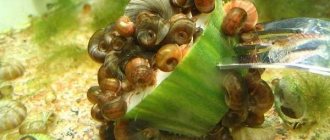Home/AQUATERRARIUM/How to get rid of snails in an aquarium: tips, experience, video
Are snails in an aquarium harmful or beneficial? The question is twofold. On the one hand, they are useful and help prevent water spoilage by eating leftover food at the bottom; on the other hand, when extra inhabitants appear, they themselves become a source of dirt. They produce a significant amount of waste, which does not improve the condition of the aquarium. In addition, the abundance of coils does not add beauty to the aquarium. When they are numerous, they are also harmful to plants.
Under favorable conditions, mollusks can multiply rapidly, and you have to look for ways to get rid of snails in an aquarium. Mechanical, biological or chemical means are used for this. We get rid of small coils immediately.
How to get rid of snails in an aquarium
Have you ever kept snails in your aquarium, but they appeared on their own? Or maybe just a few previously inhabited specimens have proliferated and are threatening the ecosystem of the entire reservoir? Such situations arise quite often even among experienced aquarists. Snails are able to benefit the aquarium by eating leftover food and parasitic algae, but once they multiply, they pose a serious threat to other inhabitants of the aquarium. Let's look at the harm caused by an abundance of coils and how to get rid of snails in an aquarium.
How do snails appear in an aquarium?
For most novice aquarists, the appearance of snails comes as a complete surprise. If you did not specifically buy snails and put them in the aquarium, this does not guarantee that they will not appear in it. In most cases, snail eggs are sold with poorly processed seaweed or may be found in soil. When you start the aquarium, they quickly hatch and begin to breed.
The best part is that these uninvited guests are the hardiest species in the aquarium. Unlike fish, they are not afraid of changes in water temperature, lack of food and pollution, but they reproduce at a high speed and with just one pair of snails you will get hundreds of new inhabitants in a couple of months.
How are they harmful?
A controlled snail population in an aquarium is beneficial. But the uncontrolled increase in the number of the most common red and black reels is the cause of the following negative phenomena:
- The aesthetic appeal of the aquarium is reduced - you must admit, hundreds of crawling snails of various sizes do not look particularly attractive. Especially if they also stick to the walls, blocking the view of the fish. Some of the snails secrete a lot of mucus, which accumulates on the walls and spoils visual perception.
- The aquarium ecosystem is harmed - too large a population of snails eats food, which sinks to the bottom, leaving bottom fish and other aquarium inhabitants hungry.
- The risk of disturbing the balance of the established ecosystem increases. Snails siphon the soil and eat most waste, but the abundance of shells in the aquarium upsets the balance and can cause diseases in the fish.
Additionally, snails are carriers of bacteria and infections, so if your fish start to get sick, after taking treatment measures, we strongly recommend that you evict the entire snail population from the tank.
spring-cleaning
This is the simplest and most radical way to get rid of black snails and melania snails in an aquarium. It is necessary to place the fish in a separate tank, drain the water from the aquarium, remove algae and soil and wash it thoroughly. Then boil all decorative items, fill in new soil and plant new algae, since snail eggs could remain on the old ones.
This method is effective but unsafe for fish. You will have to restart the aquarium and wait until the ecosystem stabilizes, and this is a lot of stress for its inhabitants.
Manual removal method
Removal method for containers no larger than 40 liters with sparse vegetation. Once a week you need to select large snails from the aquarium, and crush small ones in water (they are eaten by fish). This prevents the appearance of large populations and helps control their numbers. Dealing with extra residents this way is quite unpleasant and is not suitable for every aquarist. This control of snails is not effective in dense vegetation, since a significant part of the parasites will hide in the green mass and remain inaccessible for extraction.
Chemistry
Pet stores sell drugs that can quickly destroy the entire snail population in an aquarium. You just need to choose a product depending on the type of mollusks that have occupied the tank, and use it according to the instructions.
But many do not risk using store-bought chemicals, because this greatly upsets the balance of the reservoir’s ecosystem and can harm the health of its other inhabitants.
In addition, you will have to promptly remove dead snails from the aquarium so that they do not have time to decompose and cause an outbreak of diseases.
Natural enemies
To combat overgrown snails, fish are used... Or another type of snail. Yes, there are predatory mollusks that eat smaller relatives, for example, the Helena snail.
As for fish, tetradon, clown loach, macropod, gourami or catfish will help control or completely destroy the shellfish population.
The main thing is that when adding a predator, pay attention to whether it is able to get along with other fish and whether it will harm them. For example, tetradon and catfish can bite the fins of “peaceful” fish, and the clown loachfish becomes aggressive and can kill young animals of small breeds. As for the Helena snail, it is harmless to fish, but after exterminating the snails, it does not easily transition to regular food.
Compatibility
Helena is dangerous for gastropods of the same size. Sometimes attacked:
- sedentary fry;
- shrimp during molting;
- fish caviar
Do not place Helena in a spawning aquarium or nursery. If you keep rare species of shrimp, it is better to play it safe and not keep them with killer snails. The small size of the mollusks does not allow them to be kept with large cichlids, since the latter feast on helenas. They are indifferent to vegetation.
Traps
If you are against harsh measures and don’t want to let a lot of “strangers” into your pets, but are looking for how to get rid of red snails in an aquarium, then just install shellfish traps. This is done like this:
- Scald a cabbage leaf, cucumber or salad with boiling water.
- Place the delicacy prepared in this way on a clean flat plate.
- We put it all in the aquarium overnight.
The listed products are the favorite delicacy of snails. Most are guaranteed to slide onto it and all you have to do is pull out the plate and throw away the snails.
Fishing with bait
The method is effective for many snails in an aquarium from 5 to 500 liters, even with abundant vegetation. The bait is made from a plastic jar, at the bottom of which a treat is placed that attracts unwanted inhabitants. For shellfish, the food that will collect them is:
- lettuce leaves;
- banana peel;
- a piece of raw cucumber;
- woodlice grass;
- apple.
After placing the bait in the aquarium, it must be observed. At the moment when a significant number of mollusks have collected in it, it is pulled out and thrown away, replacing it with a new one. When removing the bait, care should be taken not to accidentally catch any fish other than parasites. Pets can swim in to enjoy the delicacy. To exterminate snails, bait should be placed twice a day every 48 hours until the number of mollusks becomes normal.
The procedure takes a lot of time, and is not very popular in the case of parasites.
Causes of snails
In fact, there are only two ways a snail can get into a fish aquarium. This may happen for the following reasons:
- After purchasing a new aquarium, you need to fill it with soil, live plants and decorations. Most often, snails or their eggs hide in purchased gravel and aquatic plants. After all, rarely do any buyers inspect them before purchasing.
- Also, the appearance of unwanted arthropods can be caused by contaminated food consisting of plankton or food made on a plant basis. They also often contain caviar, from which snails later emerge.
- In small numbers, snails do not pose any threat. But if they are multiplying rapidly, then this should be a cause for concern - this is a sign that there are problems in the aquarium.
The benefits and harms of illegal immigrants
Melania is the most common type of mollusk. Most often you can find it in an aquarium.
As for beneficial qualities, this invertebrate representative is an excellent cleanser. It clears the bottom of food debris, dead decomposing fish, and scales left over from eggs. In addition, aquatic inhabitants constantly stir up the soil, which aerates it. And this, in turn, prevents the occurrence of stagnation. But these beneficial actions are carried out only when there are not too many small snails. Otherwise, they cause only harm.
What is characteristic is that their numbers are almost impossible to control , since they multiply rapidly. This happens especially quickly in aquariums with sandy soil.
Coils of various types are the second most popular illegal shellfish, which are often found in the form of eggs or tiny snails that grow quickly and begin to reproduce further. Amazingly tenacious species!
When numerous coils begin to lack food, they begin to actively eat the vegetation in the container. In addition, they emit ammonia in large quantities, and this affects the health of the remaining inhabitants of the aquarium. It is also known that snails spread some diseases that are not dangerous for them, but can kill fish.
The appearance of the aquarium also loses its attractive appearance. The water becomes cloudy, the walls and decorations are covered with numerous coils.
Professional products
Aquarists often use chemicals against shellfish.
However, this method has side effects:
- The death of a large number of individuals can cause rapid proliferation of bacteria.
- These drugs can be harmful to microorganisms in the filter.
- It is unlikely that the drug will work against the entire population.
- Useless against caviar.
Before you purchase a particular drug, you should read the instructions for it. Copper is often included in the composition. This element is dangerous for fish and shrimp.
Among the industrial preparations you can purchase in aquarium stores:
Sera Snailpur
2 hours after using the drug, replace 1/3 of the aquarium water, while simultaneously removing paralyzed snails. Then the water is treated with Sera Aqutan conditioner in a dosage as for a full aquarium, and fresh water is added to the full volume. The treatment is repeated after 2 weeks to remove the juveniles that have hatched from the eggs.
Methods of disposal
There are different methods by which you can get rid of annoying snails. All options are absolutely safe for the main inhabitants of the underwater world - fish. But if there are shrimp or other crustaceans in the aquarium, be careful - some chemicals can destroy their population too. Basically, the methods are aimed at naturally reducing the population of mollusks; they are used first. If they do not have the desired effect, then it is worth using more radical options, but these methods will have to spend not only time, but also effort.
Special traps
Often, fish owners use homemade traps to fight snails. They are easy to make from available materials. For this option you will need an empty plastic bottle. It contains bait that will attract invertebrate inhabitants of the aquarium. You can get rid of the coils using carrots and other ingredients. It can be:
- sliced cucumbers;
- fruit slices;
- chopped lettuce leaves;
- what is used as fish food is also useful.
Then you should lower the container to the bottom of the container and leave it there. After the bottle is completely filled with shellfish, it is taken out and destroyed. To remove all illegal snails, you may need to lay several traps.
Answers to frequently asked questions
Are all fish that help in snail control suitable for an herbalist? No, not all fish are suitable for cleaning the herbalist from snails. For example, the clown loach is effective in the fight against mollusks. But it can also damage plants. In addition, she digs the soil. What to do if you don’t want to get rid of snails, but they eat plants? Mollusks eat higher plants when they are hungry. Therefore, before evicting gastropods from the aquarium, you can try feeding them additionally the same cabbage leaf or green salad, boiled vegetables or finely chopped fruits. What can I do to keep snails alive but not multiplying? Some types of snails are dioecious - for example, ampullaria. Therefore, if you keep an individual of only one sex in an aquarium, you will not have to control the population. How many shellfish are optimal to keep in an aquarium? It all depends on the volume of the tank and the size of the aquatic inhabitants. If we are talking about large species (for example, apple apples), then: - Up to 50 liters. - 3 snails; — 51–96 l. - 5 snails; — 100+ l. - 10 snails. I bought predatory fish, but they don’t want to eat snails. Why? The fish method will only work if you keep them slightly hungry. Well-fed predators are unlikely to covet gastropods.
How to get rid of snails in an aquarium?
join the discussion
Share with your friends
Snails are rightfully considered the orderlies of aquariums. After all, they eat almost all leftover food, cleaning the space. But at the same time, they can completely destroy algae and do many more irreparable things. It is because of this that many people want to get rid of these mollusks, but this is not as easy as it seems at first glance. In some cases, an integrated approach will be required, which includes mechanical cleaning.
Feeding
It eats pond snails and cattails more readily, and less readily eats melania due to its relationship with this species.
In addition to small snails, the following are suitable for feeding these carnivores:
Read also: Creamy champignon soup with cream
- tubifex;
- shrimps;
- bloodworm;
- Artemia;
- mussels;
- plant food with algae;
- beef heart and liver;
- sinking fish food;
- krill.
Having dealt with all the snails, Helena eats the leftover food for the aquarium fish. If the fish's diet contains little protein food, feed the snails Helena. Breed coils or fiss in a separate container so that predators always have food. One medium-sized snail is enough for a couple of days. Chicken eggs are also suitable for feeding.
The benefits and harms of snails in an aquarium
The most common mollusks among snails are melania. It is impossible to give a clear answer to the question of whether they are beneficial or harmful. If we talk about advantages, then such snails are considered excellent cleaners of the bottom from food debris, fish that decompose, as well as dead eggs. Some experts even call them aquarium orderlies. But this is only when their number is not too large.
However, it is almost impossible to control their population. These mollusks reproduce quickly, especially in a substrate where sand predominates. When there are too many of them, the newly created colony of snails quickly makes short work of the plants in the aquarium.
In addition, they are capable of spreading diseases and parasites, which has a bad effect on other inhabitants in the container.
Tips for population control
However, it is not necessary to fight aquarium snails; their numbers simply need to be controlled. After all, it is much easier to prevent the appearance of mollusks than to subsequently have a hard fight with them. Therefore, first of all, it is necessary to carry out preventive measures both with the substrate and with newly purchased plants or algae. Here are some of them.
- Many people buy aquariums that already contain fish and sea plants. On some of them, snails can lay eggs, and there may be too many of them. If the owner does not notice even a small clutch of eggs, then within 60-70 days a large number of small mollusks will appear in the aquarium. From the very first days they will begin to eat leaves from plants. Therefore, they need to be examined carefully.
- All plants purchased in stores must be treated with a manganese solution and also inspected for the presence of eggs. If they exist, then they must be destroyed and done manually.
- We must take care that the fish are fed correctly, that is, they should never be overfed.
- Every day it is necessary to monitor the condition of the water, especially pay attention to its temperature. This is very important if chemicals were used.
- You can buy or make your own baits or traps for harmful shellfish.
- It is also important that there are always fish in the aquarium that, in the event of a huge litter of snails, could easily deal with them.
- Cleanliness in the aquarium is very important. It is necessary to monitor not only the soil, but also the decor that is in it.
To summarize, we can say that a small amount of small mollusks such as aquarium snails is not at all harmful, but to some extent beneficial . But in the case when their number exceeds all permitted norms, they simply need to be fought.
The main thing is to take care of the other inhabitants living in the aquarium.
To learn how to get rid of snails in an aquarium, watch the following video.
Chemicals
Natural methods do not always bring results, especially if the summer is rainy. In this case, you have to use chemicals.
Using the following drugs, you can get rid of slugs and snails:
- Mesurol. These are granules that are scattered abundantly in the habitats of mollusks. Suitable for use even at low temperatures. It turns out that the effect is almost immediate - the snails are deprived of mucus. The drug is used 2-3 times, depending on the complexity of the situation and until the pests are destroyed.
- Nemaslug. The product contains nematodes that penetrate the body of snails, causing their slow death. After about 5 days, the pests stop feeding and die after 10-14 days.
A product is used to spray or water plants. It is enough to carry out 1-3 treatments per season. - Anti-slip gel. The product has no odor. The drug is applied strictly around the plants. A coating is created that provides reliable protection against slug attacks.
When grown indoors, the area around the greenhouse is treated, since pests can penetrate inside through underground tunnels.
The use of chemistry does not leave its mark on the environment. Therefore, it is strictly forbidden to exceed the dosage specified in the instructions.
How to get rid of snails in an aquarium
Many aquarists are faced with the fact that there are too many unwanted snails in the aquarium. Let's see what snails are commonly found in an aquarium, how to get rid of them using snail traps, and how to make a snail trap with your own hands.
Aquarium snail trap from a bottle
Aquarium snails are often kept on purpose in the belief that they will help keep the aquarium clean. But usually they appear when transferring aquarium plants or decorations from one aquarium to another. So, how to get rid of snails in an aquarium?
Snails reproduce very quickly and, since they can self-fertilize, one snail is enough to create an entire population in just a few weeks.
The most popular types of aquarium snails are the pond snail and the coil snail.
The coil snail prefers to feed on algae from the walls of the aquarium, uneaten fish food or their waste. But at the same time, they are able to eat dying aquarium plants well.
Pond snails eat mostly plants and once they reach large numbers they can cause some really serious damage to your aquarium plant life.
Photo of snail coil
Therefore, snails very soon become unwanted and people are looking for ways to get rid of aquarium snails. Well, or at least control their numbers.
How to get rid of coil snails in an aquarium? Firstly, avoid overfeeding the fish and promptly clean the soil from uneaten food and feces.
Secondly, a snail trap in an aquarium . The simplest trap can be made by placing pieces of lettuce or cucumber in an oblong tube like a test tube. If you don’t have a tube, a funnel made from a plastic bottle will do (see video below). Place it on the ground and leave it there overnight. In the morning you will probably find that there are a lot of snails trapped in the trap.
There is another way, more beautiful from an environmental point of view: get predators that will eat snails. Let nature work for you. This includes the aquarium fish clown botia.
Or, for example, a predatory snail, the Helena snail, (see photo). But be careful, because it can become the same problem and you will have to look for ways to kill Helena snails (see other methods above).
Helena predatory snails
Emergency measures
The sooner the aquarist begins to fight unwanted animals in the aquarium, the easier it is to solve the existing problem. If you do not control the snail population in the aquarium for many years, then, with a high degree of probability, you will have to restart the system. With such a restart, all plants must be disinfected, which makes it possible to destroy the eggs on the leaves, and the soil is also boiled, which will help get rid of all unwanted bottom inhabitants.
Problems with snails can occur for the following reasons:
- irregular soil cleaning;
- copious amounts of food settling to the bottom;
- no quarantine for new plants;
- poor biochemical parameters of water;
- mismatched population.
Regardless of the reason for the problems with coils and other snails, it is necessary to take a comprehensive approach to solving this problem, using simultaneously mechanical cleaning, various traps and special chemistry. This is the only way to, if not completely get rid of, then at least significantly reduce the population of unwanted shellfish, which will subsequently make it possible to create and maintain a successful aquarium with a luxurious underwater garden and colorful tropical fish.
You can remove snails using a number of baits
Manual cleaning
The simplest and at the same time effective way to combat snails in an aquarium is the mechanical destruction of aquatic organisms, when they are simply collected from glass, plants and from the bottom of the aquarium. This thinning of snails in the aquarium should be carried out on an ongoing basis, which will help maintain their population at a stable level. The problem is that it is impossible to completely remove snails from the aquarium by collecting them exclusively by hand. Small individuals will always remain in the ground, and it will be difficult to notice all the eggs on the foliage and glass of the aquarium.
Using various baits
The effectiveness in the fight against snails is shown by the use of various baits. This is a completely safe way to reduce their population in an aquarium. Place a piece of small cucumber, a lettuce leaf or a banana peel on the bottom. In a few hours, such a bait will be abundantly strewn with reels that have come running to the feast offered to him. All that remains to be done is to carefully remove such a piece of cucumber or lettuce leaf from the water, remove all the shellfish and repeat the procedure. By using such snail baits on a regular basis, you can significantly reduce their population.
Also with the help of various traps
Homemade and purchased traps
In pet stores today you can find various designs of shellfish traps that can solve existing problems. The operating principle of such devices is extremely simple. The mollusk crawls inside the trap at the smell of bait, and subsequently is no longer able to leave such a house. High-quality traps will not only be effective, but also completely safe to use, preventing fish and shrimp from getting inside.
Benefits of using traps:
- simplicity of design;
- efficiency;
- affordable price;
- the ability to make it yourself;
- complete safety.
You can also make such traps yourself, for which a bowl with a depth of about 5 centimeters is cut out of a plastic bottle. The edges heat up and bend inward, which will prevent prisoners from crawling out of the homemade trap. Holes are made in the bottom, to which a thread with a weight is tied. All that remains to be done is to put the bait inside and place the trap itself in the aquarium at the bottom or in a secluded place.
Such traps should be cleaned every two to three days, and in just a month you can destroy all unwanted mollusks in the aquarium.
Don't forget about the soil siphon after electricity
Application of electricity
If the aquarium is seriously clogged, electricity is used to destroy all living creatures. You just need to temporarily catch all the fish and other animals living in the aquarium. Two stranded copper wires are lowered into the aquarium, where only plants, water and snails remain. Each of the wires is connected at the other end to a 9-volt battery. A 3-5 minute treatment will be enough, the parasites will die, and all that remains to be done is to siphon off the aquarium soil to remove as many dead mollusks as possible.
After such treatment with electricity, you should re-siphon the soil every 2-3 days and change approximately 10-15 percent of the water daily with fresh, settled water. The fact is that it will be impossible to completely siphon dead snails; they will begin to decompose and rot, which will lead to an increase in nitrate and nitrite levels. Therefore, you will need to change the water regularly, and, if possible, put a small amount of carbon and other adsorbents in the external filter.
Adding chemicals to water
The use of special chemicals, subject to the dosage of adding drugs to the water, is a fairly effective and completely safe way to get rid of unwanted shellfish. Such chemicals, which can be purchased at most pet stores, should be used exactly according to the instructions.
Various chemicals will also help with the fight
Most drugs that kill snails in water contain copper, which can also be harmful to ornamental shrimp kept in an aquarium. That is why, when using such products, it is imperative to remove shrimp and decorative snails.
You can also find special bleach-based chemicals on sale that are intended to completely disinfect the aquarium. Such chemicals can only be used if you plan to completely restart the aquarium. It will be necessary to catch all fish and other aquatic organisms, remove plants from the water, and only then carry out disinfection. After this treatment, the soil is boiled, dead snails are manually removed, and the aquarium is completely restarted.
Biological methods of destroying shellfish
The most humane, safe and effective way to get rid of coil snails in an aquarium is to use their natural enemies. It is known that tetradon fish love to feast on shellfish. These fish will be able to completely clear an aquarium of 200-300 liters of shellfish in literally two to three weeks. You just need to remember that tetradons can be aggressive and will annoy other small fish. As soon as tetradon destroys all the snails, the aquarist will need to take the fish to a pet store, since it can be difficult to feed it with regular dry or live food.
The use of killer snails, which prefer to prey on other mollusks, is also very popular today. Of these killer snails, the most popular is Helena, which is small in size and has an original striped brown-yellow color. Helenas are extremely effective and can completely solve coil problems in a large aquarium.
Don't forget about snail prevention











